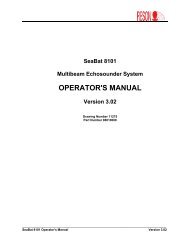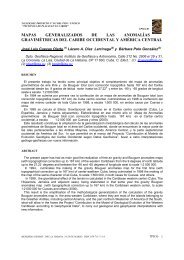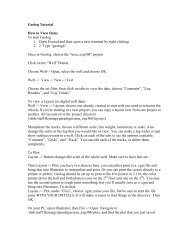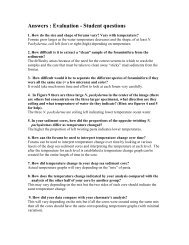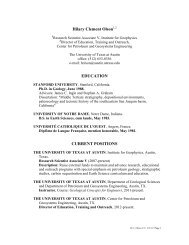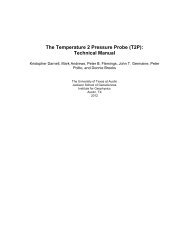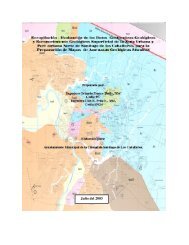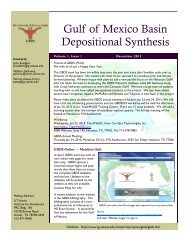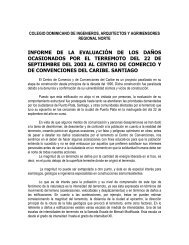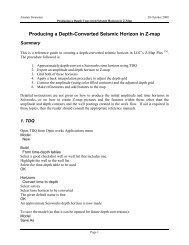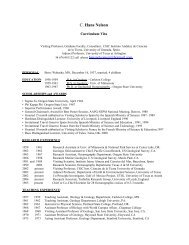IGCP Project short title: Caribbean Plate Tectonics Duration and ...
IGCP Project short title: Caribbean Plate Tectonics Duration and ...
IGCP Project short title: Caribbean Plate Tectonics Duration and ...
You also want an ePaper? Increase the reach of your titles
YUMPU automatically turns print PDFs into web optimized ePapers that Google loves.
which were obducted during strike-slip movement. The eastern Veracruz basin opened<br />
during rotation of the Yucatan block. Sinistral offset across the Chiapas Strike-Slip fault<br />
zone may reflect partial decoupling from the rest of the Yucatan block. The western basin<br />
(Cordoba platform) was dropped downward at an early stage of rotation.<br />
26<br />
EVOLUTION OF THE CRETACEOUS TO RECENT OROGENIC BELT OF<br />
NORTHERN VENEZUELA<br />
SISSON, Virginia B. <strong>and</strong> AVÉ LALLEMANT, H. G<br />
The <strong>Caribbean</strong> Mountain system (Venezuela) is both a Modern <strong>and</strong> Ancient <strong>Plate</strong><br />
Boundary <strong>and</strong> Orogen. At first glance, this mountain range appears to be a classical orogenic<br />
belt with a metamorphic "Hinterl<strong>and</strong>" <strong>and</strong> a non-metamorphic "Forel<strong>and</strong>" fold <strong>and</strong> thrust<br />
belt. However, extensive dating (mostly 40Ar/39Ar) indicates that metamorphism of the<br />
hinterl<strong>and</strong> belt took place in mid-Cretaceous time, whereas the non-metamorphic forel<strong>and</strong><br />
rocks were deformed in Cenozoic time. This situation resulted from marked right-oblique<br />
convergence of the <strong>Caribbean</strong> <strong>and</strong> South American plates along their mutual EW-trending<br />
plate boundary zone. metamorphic rocks contain blueschists <strong>and</strong> eclogites <strong>and</strong> have formed<br />
in the Leeward Antilles subduction zone along which the Atlantic plate was subducted.<br />
Blueschists <strong>and</strong> eclogites were partially exhumed by arc-parallel stretching resulting from<br />
displacement partitioning along an oblique plate<br />
margin. The collision of the Leeward Antilles arc with South America resulted in obduction<br />
of the accretionary wedge onto the South American margin <strong>and</strong> change of subduction<br />
polarity. This obduction took place in Paleocene time in the west <strong>and</strong> is still occurring in the<br />
east. The development of forel<strong>and</strong> basins <strong>and</strong> the forel<strong>and</strong> fold <strong>and</strong> thrust belt was<br />
diachronous as well <strong>and</strong> young from west to east. The oblique convergence rate vector was<br />
strongly partitioned into a plate-boundary normal component that resulted into the southvergent<br />
fold <strong>and</strong> thrust belt <strong>and</strong> a plate-boundary parallel component resulting in boundary<br />
parallel right-lateral strike slip faults along which the metamorphic belts were displaced<br />
toward the east. In addition, subduction related processes vary along strike. In the west, two<br />
high-pressure belts (Cordillera de la Costa <strong>and</strong> Villa de Cura belts) occur whereas in the east,<br />
(Margarita Isl<strong>and</strong>) only one<br />
exists. The Cordillera de la Costa belt contains eclogites that were formed at ~70 km depth.<br />
Eclogites on Margarita formed at ~45 km depth. The Villa de Cura belt blueschist formed at<br />
~30 km depth. The age of exhumation varies from mid-Cretaceous (Villa de Cura <strong>and</strong><br />
Margarita) to Eocene (Cordillera de la Costa). The dependence of depth of metamorphism<br />
<strong>and</strong> timing of exhumation of these high-P rocks on plate tectonic configuration is<br />
complicated, because of Tertiary overprint.<br />
INTERCRATONIC OROGENS: THE CARIBBEAN AND SCOTIA ARCS<br />
DALZIEL, Ian W.D., LAWVER, Lawrence A., GAHAGAN, Lisa M., <strong>and</strong> MANN, Paul.<br />
The <strong>Caribbean</strong> <strong>and</strong> Scotia arcs are two striking features of any tectonic map of the<br />
Earth <strong>and</strong> are in fact nearly identical in size. They are respectively located between North<br />
<strong>and</strong> South America, <strong>and</strong> South America <strong>and</strong> Antarctica, joining the North American<br />
Cordillera to the Andes, <strong>and</strong> the Andes to the West Antarctic continental margin orogen.<br />
Their tectonic evolutions can be related to the relative motion between the two pairs of<br />
cratons. Their evolving physiography produced critical controls, varying with time, on the<br />
movement of biota between the cratons, <strong>and</strong> between the Pacific <strong>and</strong> Atlantic Oceans. The<br />
<strong>Caribbean</strong> arc differs from the Scotia arc with the presence of the Central American l<strong>and</strong><br />
bridge. Yet differential motion along the Shackleton Fracture Zone between Cape Horn <strong>and</strong><br />
the tip of the Antarctic Peninsula has produced a ridge as shallow as 700 meters. This ridge<br />
with only minor changes in plate<br />
motions could develop into a subduction zone <strong>and</strong> generate an isl<strong>and</strong> arc. Absence of a<br />
South America-Antarctica l<strong>and</strong> bridge permits a complete <strong>and</strong> vigorous wind-driven circum-<br />
Antarctic current <strong>and</strong> intense sediment scour in Drake Passage. Cenozoic magnetic<br />
anomalies have been identified in Drake Passage <strong>and</strong> the eastern Scotia Sea where oceanic<br />
crust was formed as Antarctica separated from South America. High sedimentation rates,<br />
possible formation during the Cretaceous Normal Superchron, <strong>and</strong> a large igneous province<br />
26



